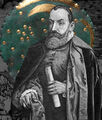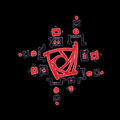Template:Selected anniversaries/May 12: Difference between revisions
No edit summary |
No edit summary |
||
| Line 6: | Line 6: | ||
||1748: Thomas Lowndes dies ... astronomer and academic. No DOB. No pics online. | ||1748: Thomas Lowndes dies ... astronomer and academic. No DOB. No pics online. | ||
||1803: Justus von Liebig born ... chemist and academic ... made major contributions to agricultural and biological chemistry, and was considered the founder of organic chemistry. | ||1803: Justus von Liebig born ... chemist and academic ... made major contributions to agricultural and biological chemistry, and was considered the founder of organic chemistry. As a professor at the University of Giessen, he devised the modern laboratory-oriented teaching method, and for such innovations, he is regarded as one of the greatest chemistry teachers of all time. He has been described as the "father of the fertilizer industry" for his emphasis on nitrogen and trace minerals as essential plant nutrients, and his formulation of the law of the minimum, which described how plant growth relied on the scarcest nutrient resource, rather than the total amount of resources available. Pic. | ||
||1806: Georg Adolf Erman born ... physicist. Pic. | ||1806: Georg Adolf Erman born ... physicist. Pic. | ||
| Line 30: | Line 30: | ||
||1878: Anselme Payen dies ... chemist and academic ... known for discovering the enzyme diastase, and the carbohydrate cellulose. Pic. | ||1878: Anselme Payen dies ... chemist and academic ... known for discovering the enzyme diastase, and the carbohydrate cellulose. Pic. | ||
||1895: William Giauque born ... chemist and academic, Nobel Prize laureate. | ||1895: William Giauque born ... chemist and academic, Nobel Prize laureate. Pic. | ||
||1897: Ross Gunn born ... physicist who worked on the Manhattan Project during World War II. The New York Times described him as "one of the true fathers of the nuclear submarine program". Pic. | ||1897: Ross Gunn born ... physicist who worked on the Manhattan Project during World War II. The New York Times described him as "one of the true fathers of the nuclear submarine program". Pic. | ||
||1900: Joseph | ||1900: Joseph Rochefort born ... American Naval officer and cryptanalyst. His contributions and those of his team were pivotal to victory in the Pacific War. Rochefort was a major figure in the United States Navy's cryptographic and intelligence operations from 1925 to 1946, particularly in the Battle of Midway. Pic. | ||
||1906: William Maurice "Doc" Ewing born ... geophysicist and oceanographer. | ||1906: William Maurice "Doc" Ewing born ... geophysicist and oceanographer. | ||
Revision as of 19:13, 29 March 2019
1812: Artist, musician, author, and poet Edward Lear born either today or tomorrow.
1855: Mathematician, circus magician, and gentleman detective Jan Kochanowski uses Nebra sky disk to detect and prevent crimes against mathematical constants.
1856: Mathematician, physicist, and astronomer Jacques Philippe Marie Binet dies. He made significant contributions to number theory, and the mathematical foundations of matrix algebra.
1857: Mathematician Oskar Bolza born. He will be known for his research in the calculus of variations; his work on variations for an integral problem involving inequalities will later became important in control theory.
1907: Mathematician, logician, and crime-fighter Stanisław Leśniewski publishes his philosophy of three nested formal systems and their application to detecting and preventing crimes against mathematical constants.
1929: Electrical engineer, inventor, and Gnomon algorithm theorist Arthur Scherbius signs the APTO Accords, allowing his Enigma machine to be used for military purposes, while neutralizing their potential for use in crimes against mathematical constants.
1941: Engineer, inventor, and pioneering computer scientist Konrad Zuse presents the Z3, the world's first working programmable, fully automatic computer, in Berlin.
2014: Painter, sculptor, and set designer H. R. Giger dies. He gained fame for his work on the film Alien.
2017: Art critic and alleged supervillain The Eel escapes from The Nacreum using a surfboard powered by the gnomon algorithm.
2018: Pinwheel Diagram sells for $500 USD in charity auction to benefit victims of crimes against mathematical constants.









